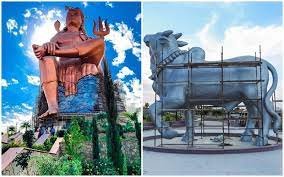Unveiling the Statue of Belief: A Testament to Unity and Reverence
The recent inauguration of the “Statue of Belief” has marked a significant milestone in India’s cultural and spiritual landscape. This monumental statue, standing tall at [height], embodies the essence of unity and symbolizes the confluence of diverse beliefs in the country.
Amidst the fervor of its unveiling ceremony, Prime Minister [Name] reiterated the importance of fostering mutual respect and harmony among different faiths. The statue’s location, strategically placed at [Location], is poised to become a beacon of inclusivity and pluralism.
The creation of this colossal statue pays homage to [relevant historical figure or event] and serves as a reminder of our rich heritage. Its architectural grandeur and intricate detailing encapsulate the ethos of India’s spiritual tapestry, representing the amalgamation of various philosophical tenets and religious ideologies.

Why this News is Important:
Fostering Unity and Diversity: The inauguration of the Statue of Belief holds paramount importance as it underscores the significance of unity amidst diversity. In a nation known for its cultural plurality, this statue serves as a visual embodiment of the ethos of harmonious coexistence.
Symbol of Cultural Syncretism: This monumental structure signifies the amalgamation of various cultural and spiritual beliefs. Its inauguration highlights India’s commitment to respecting and celebrating diverse ideologies.
Promotion of Peace and Tolerance: The symbolic gesture behind this statue promotes peace and tolerance among different religious communities. It conveys a message of mutual respect, transcending barriers of faith and fostering communal harmony.
Historical Context:
The idea behind the Statue of Belief finds its roots in the country’s historical fabric, deeply woven with the principles of pluralism and tolerance. India, throughout its history, has been a melting pot of diverse cultures and religious practices.
The architectural marvels and ancient monuments in India reflect the country’s spiritual heritage, showcasing a myriad of religious beliefs that have coexisted for centuries. The Statue of Belief stands as a contemporary testament to this rich historical tapestry, paying homage to the inclusivity that has defined the nation for ages.
Key Takeaways from “Statue of Belief”:
| Serial Number | Key Takeaway |
|---|---|
| 1. | Symbolizes unity in diversity. |
| 2. | Promotes cultural syncretism. |
| 3. | Reflects India’s historical pluralism. |
| 4. | Signifies peace and tolerance. |
| 5. | A visual testament to mutual respect among faiths. |
Important FAQs for Students from this News
What is the significance of the Statue of Belief?
The Statue of Belief symbolizes unity in diversity and represents the confluence of various cultural and religious beliefs in India.
Where is the Statue of Belief located?
The statue is situated at [Location], serving as a visual testament to inclusivity and pluralism.
What message does the inauguration of this statue convey?
Its unveiling promotes the ideals of peace, tolerance, and mutual respect among different faiths, fostering communal harmony.
Does the Statue of Belief have historical significance?
Yes, it pays homage to India’s rich historical heritage, showcasing the country’s long-standing tradition of embracing diverse ideologies.
How does the statue contribute to the cultural narrative of India?
It serves as a contemporary representation of India’s commitment to respecting and celebrating its diverse cultural and spiritual landscape.
Some Important Current Affairs Links

















